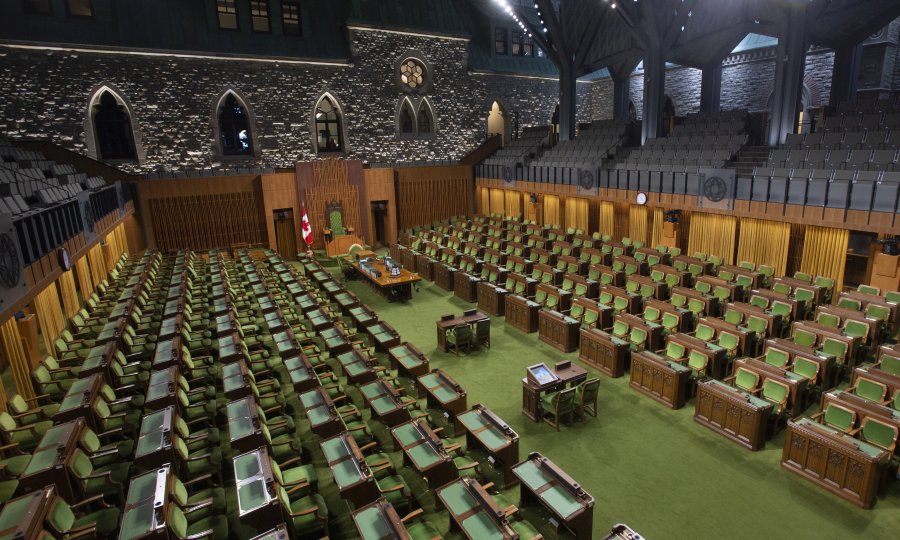By Andrew Thomson | July 5, 2022 9:16amET
PHOTO: The Canadian Press/Adrian Wyld
Every 10 years the House of Commons receives a numerical and geographic makeover, based on the Census and a representation formula found in Section 51 of the Constitution.
Independent, three-member commissions are then struck in the each province to consider new riding boundaries.
Commissioners, who are appointed by each province's chief justice and the Speaker of the House of Commons, consider geography, history, and population in crafting their proposals.
Public hearings follow, along with study by a parliamentary committee for any comments and objections.
The final map is provided to the Chief Electoral Officer.
And so last October, the latest redistribution process began with Elections Canada releasing its calculations based on population figures.
Alberta would receive three new seats, with one new seat each for British Columbia and Ontario. And Quebec would be the first province since 1966 to lose a seat, falling from 78 to 77 MPs.
That latter calculation led to the passage of a Bloc Québécois motion calling for the rejection of "any scenario for redrawing the federal electoral map that would result in Quebec losing one or more electoral districts or that would reduce Quebec's political weight in the House of Commons."
A subsequent Bloc bill was tabled to amend the Constitution and ensure Quebec never falls below a 25-per-cent share of seats in the House of Commons.
The government soon followed with Bill C-14 -- which passed the Senate on June 21.
The bill adjusts Section 51 of the Constitution Act to ensure no province loses any seats in the 2022 redistribution process.
That will require Elections Canada to perform a new calculation.
ALBERTA
Alberta’s population has grown by 17% since the last boundaries were drawn, mostly in and around Calgary and Edmonton.
That means three new seats for the province – and a significant number of boundary changes in the commission’s proposal.
All of Calgary’s ridings have been adjusted, along with the addition of Calgary McKnight in the city’s northeastern sector.
Edmonton’s two “hybrid” ridings of Edmonton—Wetaskiwin and St. Albert—Edmonton would lose their areas outside of the city limits; the former riding had the highest population growth across Canada between 2011 and 2021. Edmonton Gateway in the south-centre would be the provincial capital’s new riding, with other adjustments throughout the city.
Airdrie—Chestermere and Spruce Grove –Leduc would be Alberta’s other new electoral districts, with a number of reconfigured boundaries across the province.
BRITISH COLUMBIA
The B.C. commission proposal tried to address the province's "uneven distribution of population" and the reality that :its varied and rugged physical geography ... divides naturally into regions that cannot be easily straddled for purposes of creating electoral districts."
B.C.'s new riding, Vernon--Lake Country, would be in the Southern Interior and created from North Okanagan--Shuswap and Kelowna--Lake Country.
Major boundary changes in the Southern Interior would then affect northern B.C. ridings. Other boundary alterations and name changes are proposed for Vancouver Island, the Lower Mainland, and the Fraser Valley.
MANITOBA
Manitoba’s 14 seats would aim to reflect the province’s 11-per-cent population growth over the past decade, according to the commission proposal.
All eight of Winnipeg’s ridings have been adjusted, with a focus on 1) high growth in Winnipeg South, and 2) enlarging Charleswood—St. James—Assiniboia—Headingley to account for slower population growth – and renaming it Winnipeg West.
The large northern riding of Churchill—Keewatinook Aski has been slightly expanded to include several First Nation communities.
NEWFOUNDLAND AND LABRADOR
The commission proposed small boundary changes to account for the province’s overall population decline (0.8% from the 2011 Census) and continued growth on the Avalon Peninsula.
Labrador would remain a standalone riding despite it’s population (26,655). And several of Newfoundland and Labrador's seven ridings would see name changes.
NEW BRUNSWICK
New Brunswick's proposal includes boundary changes to all 10 ridings, along with five name changes, to account for population disparity.
Moncton and Dieppe have been the province’s fastest-growing cities over the past decade, while the current riding of Miramichi—Grand Lake has fallen 26% below the overall population average.
NOVA SCOTIA
Continued growth in and around Halifax has led the province's commission to recommend a series of changes to Nova Scotia's 11 ridings to reduce the population burden on Halifax and Halifax West.
PRINCE EDWARD ISLAND
A territory shift from Malpqeque to the neighbouring Cardigan and Egmont ridings would better balance the population among P.E.I.'s four federal districts, according to the commission proposal.
SASKATCHEWAN
The proposal for Saskatchewan's 14 federal ridings has two notable changes:
1) Transforming the north-south ridings of Cypress Hills--Grasslands and Moose Jaw--Lake Centre--Lanigan into east-west districts: Kindersley--Rosetown and Moose Jaw--Swift Current--Grasslands.
2) A reconfiguration of Saskatoon's ridings to account for population growth. This would include the newly-named Saskatoon Centre and Saskatoon--Wanuskewin districts.
The formula for determining seats has been adjusted several times since Confederation. Notably, no province can have fewer MPs than Senators, and no province can have fewer seats than they had in 1976.
The last change to the seat redistribution formula occurred in 2011 with passage of the Conservative government's Bill C-20. Alberta, British Columbia, and Ontario gained new MPs (six, six, and 15, respectively). Quebec was also assigned three new seats to maintain a similar level of representation relative to population.
The opposition NDP proposed their own bill to ensure that Quebec's proportion would remain at the same level (24.35 per cent) as 2006, when the Québécois nation resolution passed.
The Liberals, meanwhile, were worried about the transparency of the electoral commissions and how individuals would be appointed. They opposed both the Conservative and NDP bills, calling for a rebalance of the Commons without any additional seats.
The subsequent 2012 redistribution process included elimination of Saskatchewan’s mixed rural-urban ridings aside from Regina—Qu’Appelle. Meanwhile, boundary adjustments in Atlantic Canada accounted for population shifts to Halifax, Moncton, St. John’s, and other urban centres.




